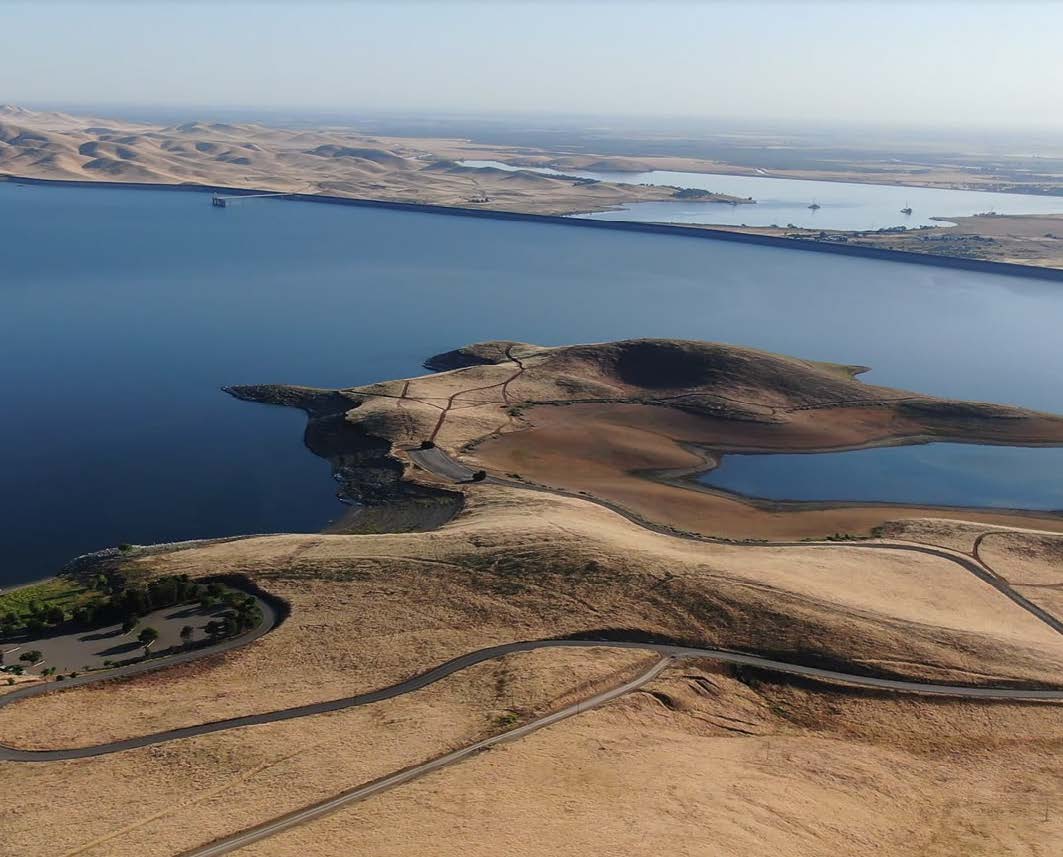 View of San Luis Reservoir, B.F. Sisk Dam, and O’Neill Forebay, looking downstream during Summer 2020
View of San Luis Reservoir, B.F. Sisk Dam, and O’Neill Forebay, looking downstream during Summer 2020
Story by Katherine Strozinski, P.E., PMP - Program Manager, California-Great Basin Region, Dam Safety Office
B.F. Sisk Dam History
B.F. Sisk Dam (formerly San Luis Dam) is a large embankment dam that impounds San Luis Reservoir, an offstream storage facility located on San Luis Creek and Cottonwood Creek approximately 12 miles west of Los Banos, California. The dam was built from 1963 through 1967 and is a principal feature of the Federal Central Valley Project (CVP). It is also a joint-use facility with the State of California, operated as part of the California State Water Project (SWP). Storage capacity and use of the joint-use facility are shared between the Bureau of Reclamation (Reclamation) and the State of California Department of Water Resources. B.F. Sisk Dam’s authorized benefits included irrigation and municipal and domestic use of water, as well as recreation and fish and wildlife benefits.
The San Luis Reservoir is the fourth largest reservoir of the CVP, exceeded only by Shasta Reservoir, Trinity Reservoir, and New Melones Reservoir. It provides 2,027,840 acre-feet of storage essential to providing water to the Nation, Californians, farmers, and local businesses. More than 250 different crops are grown in the Central Valley. These crops provide about 25% of the Nation’s food and 40% of the Nation’s fruits and nuts. The reservoir and surrounding area are part of the San Luis State Recreation Area, managed by California State Parks, which provides a wide range of recreational opportunities.
The most striking aspect of B.F. Sisk Dam is its size. The dam has a length of roughly 3.5 miles, a maximum height of over 380 feet, and a maximum width of nearly one-half mile (as measured at its base). The dam is composed of over 80 million cubic yards of earthen materials. It is a zoned earthfill embankment consisting of a rolled earth section of clay, sand, and gravel; a three-foot layer of rock riprap protecting the upstream face; and a two-foot rockfill section on the downstream face.
The San Luis Reservoir is the largest off-stream reservoir in the United States, and the reservoir is filled by pumping water out of the surrounding water conveyances structures. Water is pumped into the reservoir via O’Neill Forebay, which is filled by pumping water out of the California Aqueduct and the Delta-Mendota Canal. Alternatively, water can be discharged from San Luis Reservoir through the Gianelli Pumping-Generating Plant to generate electricity.
The Safety of Dams (SOD) Project
The dam was constructed within a seismic area near numerous active faults. Deposits of slopewash and weaker clay materials were left in some areas under the dam where it was impractical to remove them due to the length of the dam and variability of the foundation materials. Additionally, the state of practice and our understanding of the seismic hazard has evolved over the past decade.
These factors lead to the potential for the dam to experience significant damage if a remote earthquake were to occur. Such an event would have devastating impacts to the regional and national economy. Even more significant, the resulting flood wave would impact thousands of people downstream of the dam.
The San Luis Reservoir is an important CVP and SWP facility and a key component of California’s water supply system. Proper functioning of the reservoir is critical to maintaining water distribution for Federal, state, and local uses. An intensive engineering evaluation of the seismic performance of the dam from 2007-2018 led to the selection of a preferred alternative and a decision to proceed with dam modifications to mitigate the seismic risks. Although failure was determined to be very unlikely in any particular year, the consequences could be severe.
The project scope for the preferred alternative includes constructing stability berms and shear keys at several sections along the downstream face of the dam and raising the dam crest 10 feet. The project scope also includes modifications to the spillway conduit to reduce static risk. Final designs for B.F. Sisk Dam began in fiscal year (FY) 2018 and will continue through FY 2026. An Environmental Impact Statement/Environmental Impact Report was completed in 2019. Congressional authorization to construct the project was obtained in FY 2020.
The construction of the modifications at B.F. Sisk Dam will be completed in three phases. The first contract scope includes constructing shear keys and stability berms at three slopewash sections (SW36, SW145, and SW180) and modifications to the spillway. The second contract will include shear key and/or stability berms at three additional dam sections (SW165, NVS, and SVS). The third contract will include constructing a 10-foot crest raise and downstream filters along the dam and completing the overall site restoration.
In FY 2022, the first construction contract was awarded using $100 million of Bipartisan Infrastructure Law (Infrastructure Law) funding. In the fall of 2022, work on the first shear key at SW36 and the spillway was initiated and is planned to be completed in February 2023. The work under the first contract scope will continue into 2025. The second contract is planned to be awarded in FY 2025 and is expected to obligate the remaining Infrastructure Law funding allocated to the Dam Safety Program.
The B.F. Sisk Dam SOD project is planned to be completed by 2032. Project costs have been estimated to be approximately $1 billion, which makes it the largest SOD project in Reclamation’s history.
Story originally published in Water Operations and Maintenance Bulletin Spring 2023 Issue 259 U.S. Department of the Interior Infrastructure Programs and Projects. For more information or to read other stories visit https://www.usbr.gov/assetmanagement/docs/259-508-Spring-2023.pdf


